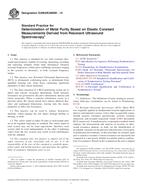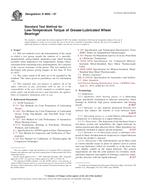1.1 These practices describe laboratory procedures for preparing a solvent or water based ink resin solution in low boiling solvent or alkaline water using two types of lab equipment; (1) an industrial blender (Sections 3-7), and (2) a laboratory roller mill (Sections 8-12).
Note 1 – ASTM Subcommittee D01.37 recommends using the industrial blender where possible.
1.2 These practices use laboratory equipment generally available in a normal, well-equipped laboratory.
1.3 These procedures are for use with ink resins intended mainly for liquid (for example, flexographic and rotogravure) inks. The type of resins is typically, but not limited to, acrylic and styrene/acrylic copolymers, polyamides, polyesters, polyvinylbutyral, and maleated/fumarated rosin esters.
1.4 The typical low boiling solvents to be used include ethanol, isopropanol, n-propanol, ethyl acetate, isopropyl acetate, and n-propyl acetate. For water based ink resin solutions, water is used in combination with ammonium hydroxide or amines such as dimethylethanolamine, monoethanolamine, and triethylamine.
1.5 The values stated in SI units are to be regarded as the standard. The values given in parentheses are for information only.
1.6 This standard does not purport to address all of the safety concerns, if any, associated with its use. It is the responsibility of the user of this standard to establish appropriate safety and health practices and determine the applicability of regulatory limitations prior to use.
Product Details
- Published:
- 06/01/2008
- Number of Pages:
- 3
- File Size:
- 1 file , 56 KB


